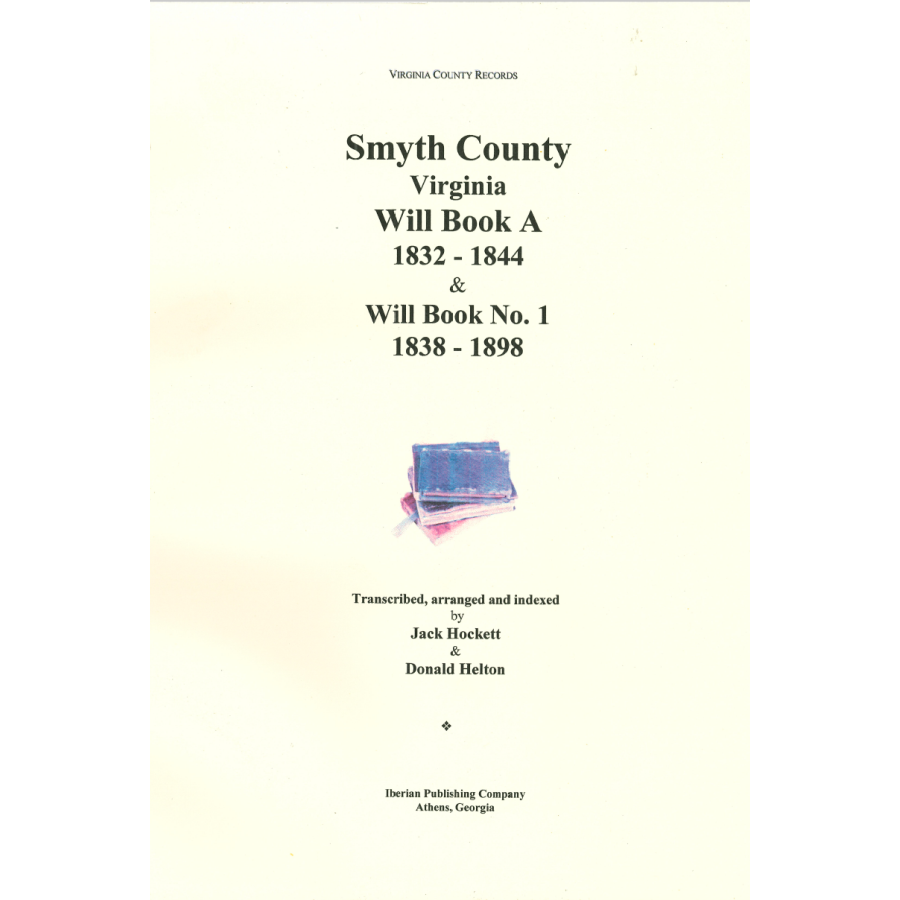Smyth County, Virginia Will Book A, 1832-1844 and Will Book No. 1, 1838-1898
Couldn't load pickup availability
This will book consists primarily of:
- (a) Last Will and Testaments: These give everything from full details of families to mere "hints" of the size and composition of families (wife, husband, children, et al). They are generally an excellent source of genealogical information. More often the LWT is written fairly soon before the death of the testator, but in some cases, quite some years before. Sometimes "bonus" information is captured in the will such as the metes and bounds of land conveyed by the LWT.
- (b) Appraisal and Inventory of Estates: This provides some clue as to the wealth (or lack thereof) of the individual concerned, proving articles which are provided to the (usually) three appraisers and the price assigned to each article. These have generally not been transcribed beyond mentioned the size of the estate, the major composition of the estate and the total, if given (frequently no total is given). For those interested in the size and wealth of their subject's estate, the information is readily available to transcribe and is frequently, in the case of large estates, exhaustive.
- (c) Sale Bill of Estate: The Sale Bill generally follows pretty closely the Inventory/Appraisement of Estate. In the case of these sales, I have recorded the names of purchasers, but attempting to only make one mention of each name or form of name (some repeats). Prices paid have not been transcribed but are easily available to the researcher. In the case of slaves, the name of the slave and the price at sale are transcribed and a few other interesting articles sometimes mentioned.
- (d) Settlement of Estates: These entries contain the "bookkeeping" of the estate administrator and lists the debits and credits of the estate; proper names are recorded (usually "received from" or "paid to". These entries can also sometimes be exhaustive and are difficult to sometimes make sense of even in full transcription. These settlements sometimes contain valuable information regarding the heirs to include their names and the amount to be distributed to each heir (at times being more specific regarding the heirs than the LWT itself.).
- (e) Assignment of Dower: By law of the commonwealth, a widow was entitled to 1/3 of the estate of her husband; these assignments of dower are listed in this LWT and are frequently good sources of the location, metes and bounds of the land assigned.
- (f) Renunciation of Dower: Not infrequently the husband of a widow would leave specific amounts to his widow in his will, instead of dower, but the widow had the right to renounce the provisions made for her in the LWT and in such cases, request her dower.
- (g) Other:
- Slaves: Information on slaves can be found in several areas, including LWTs, Estate Sales, Inventories, and sometimes other places. They having generally, at that time, no surnames, their given name is always capitalized in this transcription.
- Names/Forms: The English speaking clerk (who was wary of most punctuation, by the way), frequently butchered the German [and Swiss German/Alsatian German] names, especially; in a few instances, the German name itself has been translated into English. This segment of the early population was very numerous and extremely important in and for Smyth County.
The bulk of the early settlers came especially from Pennsylvania (with Chester County being especially prominent as a place of origin); for this reason I call Philadelphia (port of arrival) "The Jamestown of Smyth County"; some Germans and Scottish/Ulsterite and also English (rarely mentioned but numerous) came also from Pennsylvania, sometimes stopping for a generation or more in Frederick, Shenandoah, and especially Augusta/Botetourt/Rockbridge County. It should here be pointed out that a great number of the early inhabitants listing "NC" as place of birth were short-term persons of NC background, coming primarily also from PA to NC and thence to Smyth; a fairly rare, small group of persons coming from the counties in or bordering the Piedmont of NC may have come there from the E. of NC or from VA. Lastly, the minority of persons who crossed the water gaps, deemed frequently "Eastern Virginia English" trickled into Smyth, mainly from the Piedmont Counties of Louisa, Amelia, Powhatan, Buckingham, Cumberland et al. Finally, particularly in the St. Clair District, the "New England Colony" were a strong and fairly numerous contingent, originating in MA, CT and RI, frequently stopping in Ulster and Westchester Counties, NY and thence to (now) Smyth County. This "colony" had a small spillover into neighboring Washington County; many of them were former tenants of the patroons in NY. This latter group makes Smyth County unique in Virginia in having a sizeable contingent of (originally) New England people.
Thomas Jack Hockett and Donald Helton
2023, paper, 161 pp.
107-SWB1
